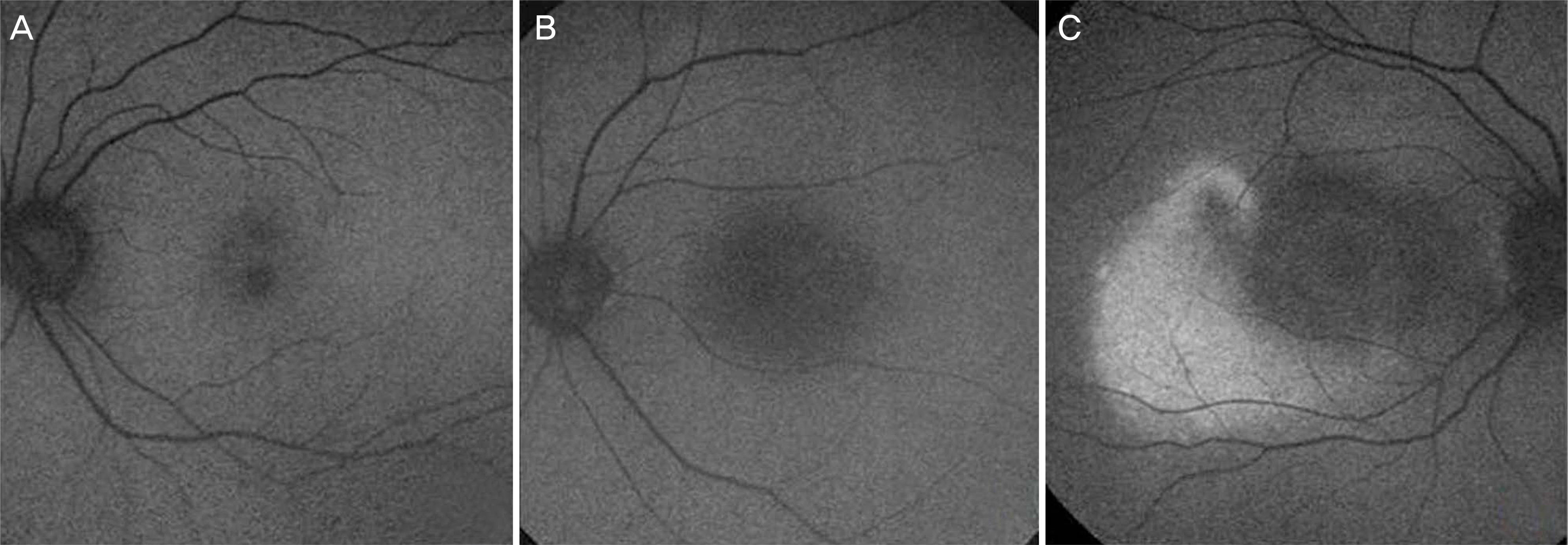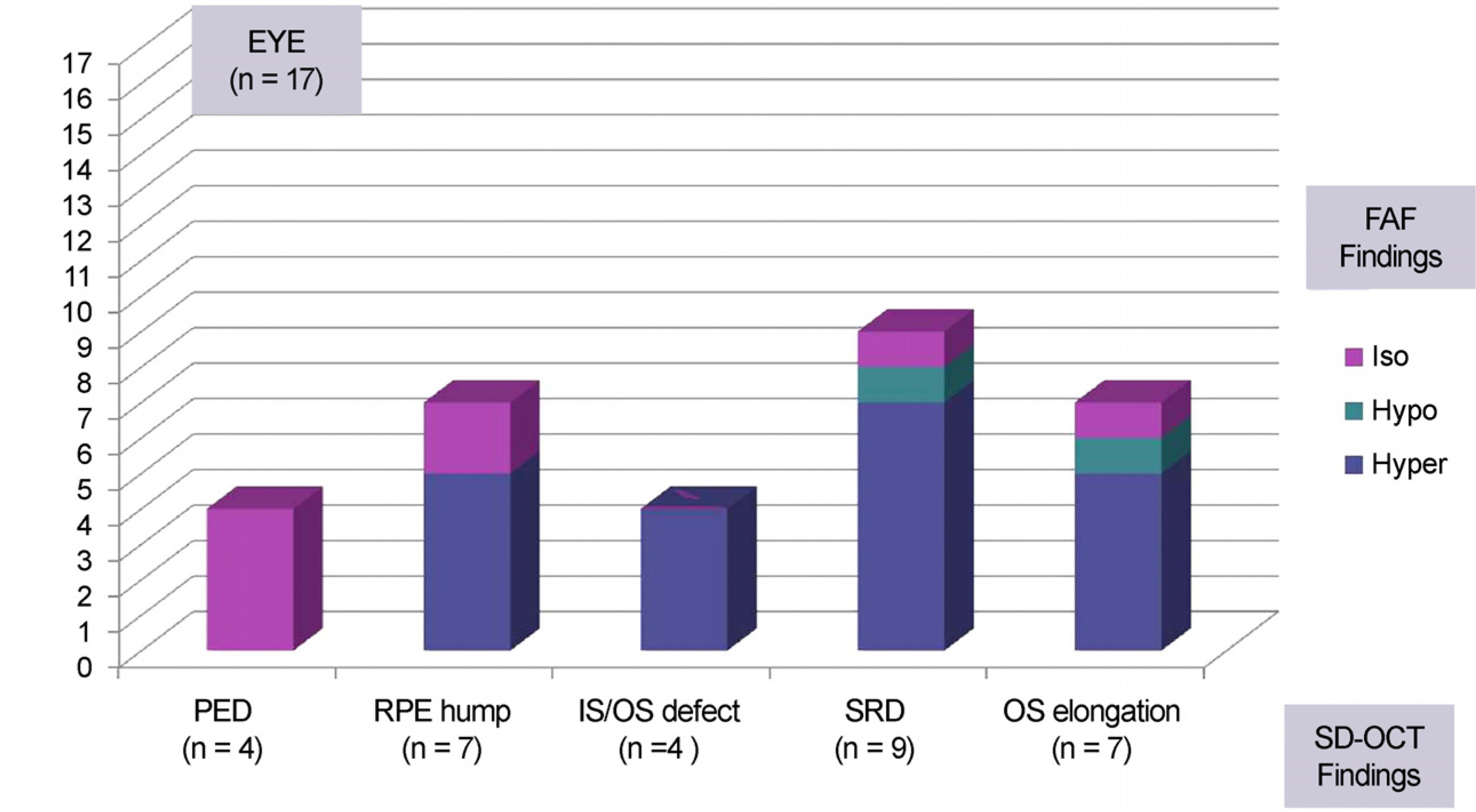J Korean Ophthalmol Soc.
2016 May;57(5):763-771. 10.3341/jkos.2016.57.5.763.
Outer Retinal Layers Alterations in Chronic Central Serous Chorioretinopathy: Spectral Domain-OCT and Fundus Autofluorescence Findings
- Affiliations
-
- 1Department of Ophthalmology, Daegu Fatima Hospital, Daegu, Korea. mjmom99@naver.com
- KMID: 2212719
- DOI: http://doi.org/10.3341/jkos.2016.57.5.763
Abstract
- PURPOSE
To document alteration of the outer retinal layers and fundus autofluorescence (FAF) change in eyes with chronic central serous chorioretinopathy (CSCR).
METHODS
Seventeen eyes of fifteen patients diagnosed with chronic CSCR from January 2014 to March 2015 with at least 6 months of follow-up and no history of surgery were enrolled in this study. Morphologic alterations in the retinal pigment epithelium (RPE), the photoreceptor inner segment/outer segment (IS/OS) junction layer, and the outer retina were evaluated by Spectral domain optical coherence tomography (SD-OCT). The FAF images were obtained via Heidelberg Retina Angiogram using a view mode of 30° and were described using distribution patterns of retinal autofluorescence compared to background autofluorescence. After tomographic alignment of the FAF intensities with the OCT findings, we analyzed and assessed the alteration of the outer retinal layers and the characteristics of retinal autofluorescence.
RESULTS
RPE detachment lesions in SD-OCT showed little or no change in autofluorescence pattern. Five of seven eyes with RPE humps in SD-OCT showed hyper-fluorescence in FAF. All of the eyes with defects or changes of the reflective line representing the IS/OS junction in SD-OCT correlated with hyper-fluorescence in FAF. Seven of nine eyes with persistent subretinal detachment (SRD) showed specific ring-shaped hyper-fluorescence in FAF matching up with the border of the SRD, and five eyes with photoreceptor OS elongation within SRD showed a granular type of hyper-fluorescence within the ring-shaped hyper-fluorescence in FAF.
CONCLUSIONS
In chronic CSCR, we found that RPE humps, the lesion IS/OS junction defect, the border of SRD, photoreceptor OS elongation in SD-OCT correlate with hyper-fluorescence lesions in FAF. The areas of the autofluorescence changes in the FAF images are associated with the extent of change in the RPE and outer retina.
Keyword
MeSH Terms
Figure
Reference
-
References
1. Nicholson B. Noble J. Forooghian F. Meyerle C. Central serous chorioretinopathy: update on pathophysiology and treatment. Surv Ophthalmol. 2013; 58:103–26.
Article2. Ross A. Ross AH. Mohamed Q. Review and update of central serous chorioretinopathy. Curr Opin Ophthalmol. 2011; 22:166–73.
Article3. Kim YY. Flaxel CJ. Factors influencing the visual acuity of chronic central serous chorioretinopathy. Korean J Ophthalmol. 2011; 25:90–7.
Article4. Song IS. Shin YU. Lee BR. Time-periodic characteristics in the morphology of idiopathic central serous chorioretinaopthy evaluated by volume scan using spectral-domain optical coherence tomography. Am J Ophthalmol. 2012; 154:366–75.5. von Rückmann A. Fitzke FW. Bird AC. Distribution of fundus autofluorescence with a scanning laser ophthalmoscope. Br J Ophthalmol. 1995; 79:407–12.6. Yalcinbayir O. Gelisken O. Akova-Budak B, et al. Correlation of spectral domain optical coherence tomography findings and visual acuity in central serous chorioretinopathy. Retina. 2014; 34:705–12.
Article7. Framme C. Walter A. Gabler B, et al. Fundus autofluorescence in acute and chronic-recurrent central serous chorioretinopathy. Acta Ophthalmol Scand. 2005; 83:161–7.
Article8. Park YM. Lee MH. Lee JE. Oum BS. Fudnus autofluorescence in acute and chronic-recurrent central serous chorioretinopathy. J Korean Opthalmol Soc. 2009; 50:1353–8.9. Roisman L. Lavinsky D. Magalhaes F, et al. Fundus autofluorescence and spectral domain OCT in central serous chorioretinopathy. J Ophthalmol. 2011; 2011:706849.
Article10. Sekiryu T. Iida T. Maruko I, et al. Infrared fundus autofluorescence and central serous chorioretinopathy. Invest Ophthalmol Vis Sci. 2010; 51:4956–62.
Article11. Spai de RF. Klancnik JM Jr. Fundus autofluorescence and central serous choroiretinopathy. Ophthalmology. 2005; 112:825–33.12. Dinc UA. Tatlipinar S. Yenerel M, et al. Fundus autofluorescence in acute and chronic central serous chorioretinopathy. Clin Exp Optom. 2011; 94:452–7.
Article13. Teke MY. Elgin U. Nalcacioglu-Yuksekkaya P, et al. Comparison of autofluorescence and optical coherence tomography findings in acute and chronic central serous chorioretinopathy. Int J Ophthlmol. 2014; 7:350–4.14. Spaide R. Autofluorescence from the outer retina and subretinal space: hypothesis and review. Retina. 2008; 28:5–35.15. Matsumoto H. Kishi S. Sato T. Mukai R. Fundus autofluorescence of elongated photoreceptor outer segments in central serous chorioretinopathy. Am J Ophthalmol. 2011; 151:617–23.
Article
- Full Text Links
- Actions
-
Cited
- CITED
-
- Close
- Share
- Similar articles
-
- Outer Retinal Tubulation in Chronic Central Serous Chorioretinopathy
- Central Serous Chorioretinopathy in a Patient with Retinal Macrovessel
- Spectral Domain OCT Findings of Asymptomatic Fellow Eyes in Central Serous Chorioretinopathy
- Morphologic Changes in Acute Central Serous Chorioretinopathy Using Spectral Domain Optical Coherence Tomography
- Correlation Between Optical Coherence Tomography and Visual-Acuity in Chronic Central Serous Chorioretinopathy Treated with Half Dose Photodynamic Therapy






